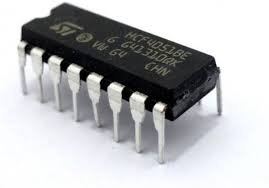IC 4007 – CMOS Quad Analog Switch (Pack of 2)
24 in stock
The IC 4007 is a quad CMOS analog/digital complementary metal-oxide-semiconductor (CMOS) logic gate. It includes four independent sections: two NAND gates, two NOR gates, and a set of complementary inverters. This versatile IC can be used for a variety of logic functions and signal processing tasks in digital and analog circuits.
₹67.67 ₹141.60 (Incl. GST)
24 in stock
IC 4007 – CMOS Quad Analog Switch (Pack of 2)
Overview
The IC 4007 is a versatile CMOS (Complementary Metal-Oxide-Semiconductor) quad analog switch integrated circuit. It includes four independent analog switches, each of which can be used to control the flow of analog signals in various applications. These switches are designed for use in high-speed digital and analog switching circuits, making them ideal for signal routing, multiplexing, and other applications where precise control of analog signals is required.
Features
- Quad Analog Switch: Four independent analog switches in a single package.
- Wide Operating Voltage Range: Operates from 3V to 15V, accommodating a range of power supplies.
- Low Power Consumption: CMOS technology ensures minimal power usage.
- High-Speed Switching: Capable of fast switching speeds for dynamic signal control.
- Low On-Resistance: Provides minimal signal degradation during switching.
- Standard Pin Configuration: Easily integrates into existing circuit designs.
- High Noise Immunity: Reliable performance in noisy environments.
Pin Configuration
The IC 4007 is typically available in a 14-pin Dual In-line Package (DIP) configuration. The pinout is as follows:
- Pin 1: Output of Switch 1
- Pin 2: Input of Switch 1
- Pin 3: Control of Switch 1
- Pin 4: Output of Switch 2
- Pin 5: Input of Switch 2
- Pin 6: Control of Switch 2
- Pin 7: GND (Ground)
- Pin 8: Output of Switch 3
- Pin 9: Input of Switch 3
- Pin 10: Control of Switch 3
- Pin 11: Output of Switch 4
- Pin 12: Input of Switch 4
- Pin 13: Control of Switch 4
- Pin 14: Vcc (Positive Supply Voltage)
Working Principle
Each switch within the IC 4007 operates as an analog switch, meaning it can control the flow of analog signals based on the control input. When the control input is high, the switch connects the input to the output. When the control input is low, the connection is open, and no signal is transmitted.
- Control Input: Determines whether the analog signal is allowed to pass through or blocked.
- Analog Signal Path: Allows or blocks the passage of the analog signal from input to output based on the control signal.
Applications
- Signal Routing: Used to route analog signals to different paths or destinations.
- Multiplexing: Allows multiple signals to share a single path by switching between them.
- Audio Switching: Routes audio signals in various audio equipment.
- Data Acquisition: Switches between different data sources in measurement systems.
- Signal Conditioning: Routes and controls signals in analog processing circuits.
Example Circuit
- Analog Signal Router: Connect multiple analog signals to a single output or switch between different sources based on control inputs.
- Audio Selector: Switch between different audio sources in a mixing console or audio device.
- Data Multiplexer: Route data from different sensors or inputs to a single processing unit based on control signals.
Advantages
- Versatile: Can handle a variety of analog signal switching tasks.
- Low Power Consumption: CMOS technology ensures efficient power usage.
- High-Speed Switching: Fast response times for dynamic applications.
- Low On-Resistance: Minimizes signal degradation and loss.
- Ease of Use: Standard pin configuration and simple design make integration straightforward.
Conclusion
The IC 4007 is a valuable component for applications requiring precise control and switching of analog signals. With its four independent analog switches, wide operating voltage range, and high-speed switching capabilities, it offers flexibility and efficiency for various signal routing, multiplexing, and conditioning tasks. Whether used in audio systems, data acquisition setups, or general analog signal processing, the IC 4007 provides reliable performance and ease of integration into complex electronic circuits.





